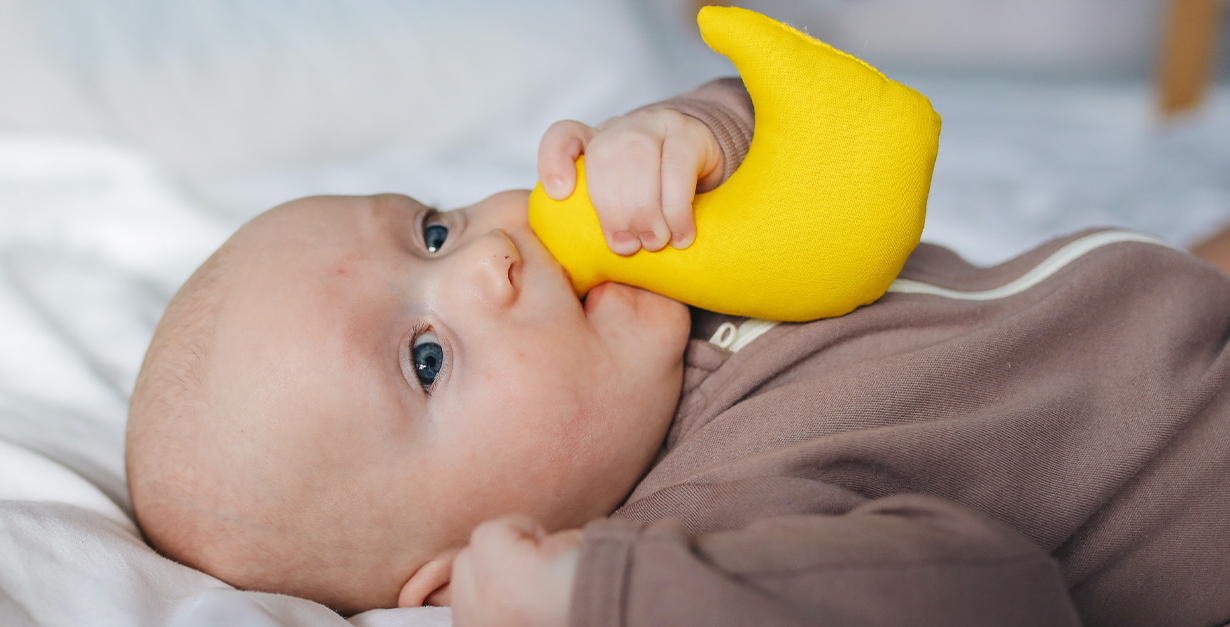Is Teething Keeping Your Baby Awake? Here’s How to Help
Is Teething Keeping Your Baby Awake? Here’s How to Help
Your baby has so many milestones in their first year. Rolling over, sitting up, crawling, walking, and growing teeth. If your child has trouble sleeping while he’s teething, you may be in for quite a few late nights. There is good news, however!
Often, you won’t notice that your child has had a new tooth erupt until he smiles, laughs, or bites you — but that’s a whole other article. So how does teething affect sleep? On one hand, it may not change your baby’s sleep at all. However, if your child is uncomfortable, you may find that both naps and nighttime sleep become a bit of a fight.
Some indicators that your child may be teething include:
- Low grade fever
- Increased drooling
- Diaper rash (surprising, but true!)
- Increased sucking
- Increased biting (on EVERYTHING)
- Pulling on his ears
- Decreased appetite (it may be uncomfortable to eat)
 Teething Can Cause a Cranky Baby
Teething Can Cause a Cranky Baby
Thankfully, once your baby’s tooth pops out, you should have your happy, sweet baby back! During a tooth eruption, your baby should be cranky! That little tooth is cutting through his gums to work its way out. If your child does show symptoms of teething, expect that you will see these symptoms both day and night.
While teething may seem like a typical sleep regression, your baby’s reason for not sleeping is a bit different, as he may be hurting and unable to say ‘mom, this tooth is pushing up through my gums and it HURTS!’ Since teeth can take awhile — sometimes up to a month — to actually erupt, you may find that your baby has wonderful days, and then suddenly is fussy, complaining, and refusing to sleep.
Luckily, there are a few things that you can do to help soothe your teething baby both during the day and when he goes to sleep.
Want to know more about typical sleep regressions?
Read: Sleep Regression: When, Why, and How to Solve It!
Find Your Go-To “Trick”
There are lots of non-medicated ways that you can help your baby soothe teething pain during the day. Some of the most popular options are simply frozen toys or foods. A frozen washcloth, a toothbrush, a sock with ice chips, a gel-filled teether, or large chunks of frozen fruit are all great options. Teething relief doesn’t have to be frozen, however. There are lots of great natural rubber teethers out there that travel well and are easy for baby to chew on.

Avoid Benzocaine
The FDA has issued a warning about benzocaine (found in Anbesol and Orajel), stating that it should not be administered to babies under 2 years of age. There are many natural options on the market that will provide your baby with teething relief without the dangers of benzocaine.
Need to soothe a fussy baby?
Read: Soothing a Fussy Baby: Using Motion and Cues to Calm the Crankiness
Encourage Sleep
The above options are great, until your baby needs to sleep. Your baby can’t exactly chew on a piece of frozen watermelon in the crib! So what can you do to help? Talk to your pediatrician about the best pain relieving option for your baby. Some doctors recommend Tylenol and some recommend Motrin, so it’s good to check.
Remember that a single dose of pain reliever generally only covers between 4 and 6 hours, so expect that you’ll have to re-administer the pain reliever during the night.
Do Some Math
When you administer your baby’s pain reliever, save yourself a headache and do a little bit of math. If your baby still wakes at night for feedings, administer his first dose of pain reliever 4-6 hours before your normal feeding time. This will prevent your baby from waking more than necessary, and allow you both to get some sleep. Be sure to consult with your pediatrician for dosing instructions.
For example, if your baby always does a dream feed at 11:00 p.m., then you would want to give your baby his pain reliever between 5 and 7:00 p.m. The second dose can be administered during your dream feed.

Wake Your Baby
This advice may shock you, but if you have a child who no longer wakes at night, you may want to consider waking him when it’s time to administer a second dose of pain reliever. You can absolutely let him sleep until he wakes up, but consider this: if your child wakes in pain, then you’ve got a fully awake, fussy toddler who is going to have to wait about 30 minutes for the pain reliever to kick in.
You may want to approach your baby’s second dose of medicine as you would a dream feed. Gently sit your baby up, and administer his medicine via syringe and watch to make sure that he swallows it. Then put him back down, and he should fall right to sleep. If he fusses, it’s okay to soothe him with a quick pat or ‘shushing’ for a brief time before you leave his room.
When teething is over, you may need to re-start The Shuffle:
Read: How to Get Your Baby Back to Sleep after Being Sick
Teething is Temporary…for 2 or 3 Years Straight!
When all is said and done, remember that this bout of teething is temporary. You will get a reprieve before more teeth erupt. Make it your goal to keep your baby as pain-free as possible, and remember that if one thing doesn’t work, there is a list of other options that you can try.
Tried everything? If your child’s symptoms continue for several days and nothing is giving your baby relief, contact your pediatrician. They may have ideas that aren’t covered here.
One last thing: Don’t wait until your baby or toddler is done teething to begin sleep coaching. You could be waiting for 3 years! That being said, try not to start sleep training when you know your baby is teething. Use this time to prepare for sleep coaching and once that tooth pops out get started on sleep!
Have no idea where to begin solving your child’s sleep issues?
Start with this guide.
The post Is Teething Keeping Your Baby Awake? Here’s How to Help appeared first on The Sleep Lady.
https://ift.tt/3ejX4ug from The Sleep Lady https://ift.tt/3ekRsA2


Post a Comment